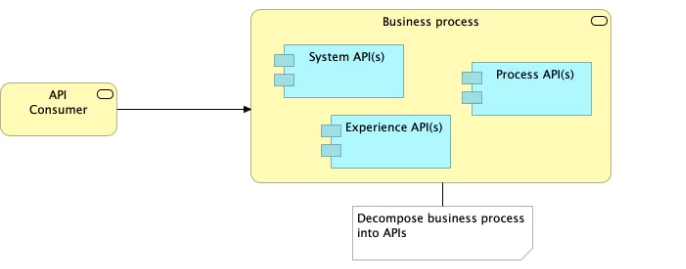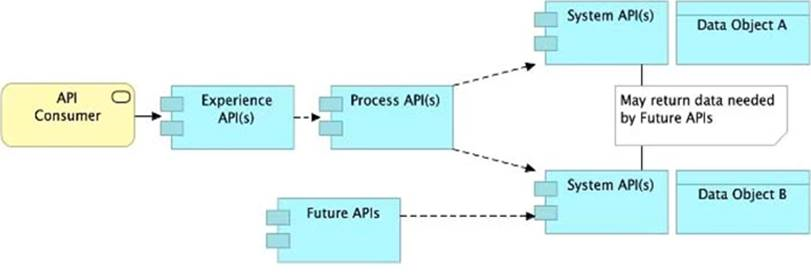MuleSoft Certified Platform Architect - Level 1 MAINTENANCE MCPA-Level-1-Maintenance Exam Practice Test
A new upstream API Is being designed to offer an SLA of 500 ms median and 800 ms maximum (99th percentile) response time. The corresponding API implementation needs to sequentially invoke 3 downstream APIs of very similar complexity.
The first of these downstream APIs offers the following SLA for its response time: median: 100 ms, 80th percentile: 500 ms, 95th percentile: 1000 ms.
If possible, how can a timeout be set in the upstream API for the invocation of the first downstream API to meet the new upstream API's desired SLA?
Answer : B
Correct Answer: Set a timeout of 100ms; that leaves 400ms for other two
*****************************************
Key details to take from the given scenario:
>> Upstream API's designed SLA is 500ms (median). Lets ignore maximum SLA response times.
>> This API calls 3 downstream APIs sequentially and all these are of similar complexity.
>> The first downstream API is offering median SLA of 100ms, 80th percentile: 500ms; 95th percentile: 1000ms.
Based on the above details:
>> We can rule out the option which is suggesting to set 50ms timeout. Because, if the median SLA itself being offered is 100ms then most of the calls are going to timeout and time gets wasted in retried them and eventually gets exhausted with all retries. Even if some retries gets successful, the remaining time wont leave enough room for 2nd and 3rd downstream APIs to respond within time.
>> The option suggesting to NOT set a timeout as the invocation of this API is mandatory and so we must wait until it responds is silly. As not setting time out would go against the good implementation pattern and moreover if the first API is not responding within its offered median SLA 100ms then most probably it would either respond in 500ms (80th percentile) or 1000ms (95th percentile). In BOTH cases, getting a successful response from 1st downstream API does NO GOOD because already by this time the Upstream API SLA of 500 ms is breached. There is no time left to call 2nd and 3rd downstream APIs.
>> It is NOT true that no timeout is possible to meet the upstream APIs desired SLA.
As 1st downstream API is offering its median SLA of 100ms, it means MOST of the time we would get the responses within that time. So, setting a timeout of 100ms would be ideal for MOST calls as it leaves enough room of 400ms for remaining 2 downstream API calls.
An organization wants MuleSoft-hosted runtime plane features (such as HTTP load balancing, zero downtime, and horizontal and vertical scaling) in its Azure environment. What runtime plane minimizes the organization's effort to achieve these features?
Answer : A
Correct Answer: Anypoint Runtime Fabric
*****************************************
>> When a customer is already having an Azure environment, It is not at all an ideal approach to go with hybrid model having some Mule Runtimes hosted on Azure and some on MuleSoft. This is unnecessary and useless.
>> CloudHub is a Mulesoft-hosted Runtime plane and is on AWS. We cannot customize to point CloudHub to customer's Azure environment.
>> Anypoint Platform for Pivotal Cloud Foundry is specifically for infrastructure provided by Pivotal Cloud Foundry
>> Anypoint Runtime Fabric is right answer as it is a container service that automates the deployment and orchestration of Mule applications and API gateways. Runtime Fabric runs within a customer-managed infrastructure on AWS, Azure, virtual machines (VMs), and bare-metal servers.
-Some of the capabilities of Anypoint Runtime Fabric include:
-Isolation between applications by running a separate Mule runtime per application.
-Ability to run multiple versions of Mule runtime on the same set of resources.
-Scaling applications across multiple replicas.
-Automated application fail-over.
-Application management with Anypoint Runtime Manager.
What is true about automating interactions with Anypoint Platform using tools such as Anypoint Platform REST APIs, Anypoint CU, or the Mule Maven plugin?
Answer : C
Correct Answer: By default, the Anypoint CLI and Mule Maven plugin are NOT
*****************************************
>> We CANNOT apply API policies to the Anypoint Platform APIs like we can do on our custom written API instances. So, option suggesting this is FALSE.
>> Anypoint Platform APIs can be used for automating interactions with both CloudHub and customer-hosted Mule runtimes. Not JUST the CloudHub. So, option opposing this is FALSE.
>> Mule Maven plugin is NOT mandatory for deployment to customer-hosted Mule runtimes. It just helps your CI/CD to have smoother automation. But not a compulsory requirement to deploy. So, option opposing this is FALSE.
>> We DO NOT have any such special roles and permissions on the platform to separately control access for some users to have Anypoint CLI and others to have Anypoint Platform APIs. With proper general roles/permissions (API Owner, Cloudhub Admin etc..), one can use any of the options (Anypoint CLI or Platform APIs). So, option suggesting this is FALSE.
Only TRUE statement given in the choices is that - Anypoint CLI and Mule Maven plugin are NOT included in the Mule runtime, so are NOT available to be used by deployed Mule applications.
Maven is part of Studio or you can use other Maven installation for development.
CLI is convenience only. It is one of many ways how to install app to the runtime.
These are definitely NOT part of anything except your process of deployment or automation.
Refer to the exhibit.

What is the best way to decompose one end-to-end business process into a collaboration of Experience, Process, and System APIs?
A) Handle customizations for the end-user application at the Process API level rather than the Experience API level

B) Allow System APIs to return data that is NOT currently required by the identified Process or Experience APIs

C) Always use a tiered approach by creating exactly one API for each of the 3 layers (Experience, Process and System APIs)

D) Use a Process API to orchestrate calls to multiple System APIs, but NOT to other Process APIs

Answer : B
Correct Answer: Allow System APIs to return data that is NOT currently required by
*****************************************
>> All customizations for the end-user application should be handled in 'Experience API' only. Not in Process API
>> We should use tiered approach but NOT always by creating exactly one API for each of the 3 layers. Experience APIs might be one but Process APIs and System APIs are often more than one. System APIs for sure will be more than one all the time as they are the smallest modular APIs built in front of end systems.
>> Process APIs can call System APIs as well as other Process APIs. There is no such anti-design pattern in API-Led connectivity saying Process APIs should not call other Process APIs.
So, the right answer in the given set of options that makes sense as per API-Led connectivity principles is to allow System APIs to return data that is NOT currently required by the identified Process or Experience APIs. This way, some future Process APIs can make use of that data from System APIs and we need NOT touch the System layer APIs again and again.

An Order API must be designed that contains significant amounts of integration logic and involves the invocation of the Product API.
The power relationship between Order API and Product API is one of "Customer/Supplier", because the Product API is used heavily throughout the organization and is developed by a dedicated development team located in the office of the CTO.
What strategy should be used to deal with the API data model of the Product API within the Order API?
Answer : C
Correct Answer: Convince the development team of the product API to adopt the API
*****************************************
Key details to note from the given scenario:
>> Power relationship between Order API and Product API is customer/supplier
So, as per below rules of 'Power Relationships', the caller (in this case Order API) would request for features to the called (Product API team) and the Product API team would need to accomodate those requests.
What Anypoint Connectors support transactions?
Answer : A
What is true about where an API policy is defined in Anypoint Platform and how it is then applied to API instances?
Answer : B
Correct Answer: The API policy is defined in API Manager for a specific API
*****************************************
>> Once our API specifications are ready and published to Exchange, we need to visit API Manager and register an API instance for each API.
>> API Manager is the place where management of API aspects takes place like addressing NFRs by enforcing policies on them.
>> We can create multiple instances for a same API and manage them differently for different purposes.
>> One instance can have a set of API policies applied and another instance of same API can have different set of policies applied for some other purpose.
>> These APIs and their instances are defined PER environment basis. So, one need to manage them seperately in each environment.
>> We can ensure that same configuration of API instances (SLAs, Policies etc..) gets promoted when promoting to higher environments using platform feature. But this is optional only. Still one can change them per environment basis if they have to.
>> Runtime Manager is the place to manage API Implementations and their Mule Runtimes but NOT APIs itself. Though API policies gets executed in Mule Runtimes, We CANNOT enforce API policies in Runtime Manager. We would need to do that via API Manager only for a cherry picked instance in an environment.
So, based on these facts, right statement in the given choices is - 'The API policy is defined in API Manager for a specific API instance, and then ONLY applied to the specific API instance'.